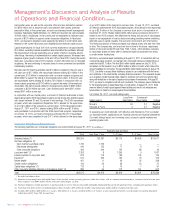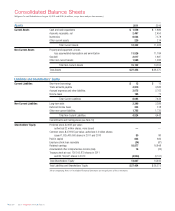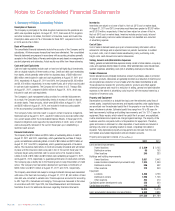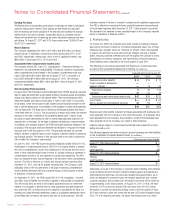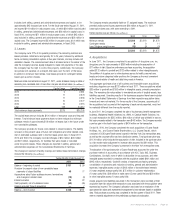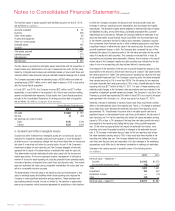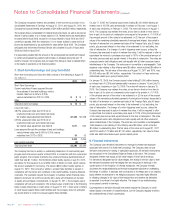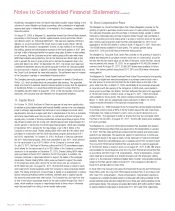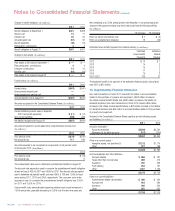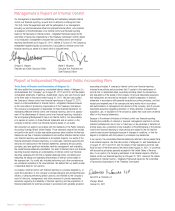Walgreens 2011 Annual Report Download - page 32
Download and view the complete annual report
Please find page 32 of the 2011 Walgreens annual report below. You can navigate through the pages in the report by either clicking on the pages listed below, or by using the keyword search tool below to find specific information within the annual report.
Notes to Consolidated Financial Statements (continued)
Earnings Per Share
The dilutive effect of outstanding stock options on earnings per share is calculated
using the treasury stock method. Stock options are anti-dilutive and excluded
from the earnings per share calculation if the exercise price exceeds the average
market price of the common shares. Outstanding options to purchase common
shares were excluded from the earnings per share calculations because they were
anti-dilutive. At August 31, 2011 and 2010, these options were 16,869,061 and
30,661,551, respectively.
Interest Expense
The Company capitalized $10 million, $12 million and $16 million of interest
expense as part of significant construction projects during fiscal 2011, 2010
and 2009, respectively. Interest paid, which is net of capitalized interest, was
$89 million in fiscal years 2011, 2010 and 2009.
Accumulated Other Comprehensive Income (Loss)
The Company follows ASC Topic 715, Compensation – Retirement Benefits, for
treatment of its postretirement medical liability. The amount included in accumulated
other comprehensive income related to the Company’s postretirement plan was
a gain of $4 million ($16 million after tax) at August 31, 2011, compared to a
loss of $57 million ($24 million after tax) at August 31, 2010. The minimum
postretirement liability totaled $407 million and $441 million at August 31, 2011
and 2010, respectively.
New Accounting Pronouncements
In August 2010, the Financial Accounting Standards Board (FASB) issued an exposure
draft on lease accounting that would require entities to recognize assets and liabilities
arising from lease contracts on the balance sheet. The proposed exposure draft
states that lessees and lessors should apply a “right-of-use model” in accounting
for all leases. Under the proposed model, lessees would recognize an asset for the
right to use the leased asset, and a liability for the obligation to make rental payments
over the lease term. The lease term is defined as the longest possible term that is
“more likely than not” to occur. The accounting by a lessor would reflect its retained
exposure to the risks or benefits of the underlying leased asset. A lessor would
recognize an asset representing its right to receive lease payments based on the
expected term of the lease. On the basis of feedback received from comment letters,
roundtables, and outreach sessions, the FASB has made significant changes to the
proposals in the exposure draft and therefore has decided to re-expose the revised
exposure draft in the first quarter of 2012. The proposed standard, as currently
drafted, will have a material impact on the Company’s reported results of operations
and financial position. The impact of this exposure draft is non-cash in nature and
will not affect the Company’s cash position.
On June 16, 2011, the FASB issued Accounting Standards Update (ASU) 2011-05,
Presentation of Comprehensive Income. ASU 2011-05 requires entities to present
the total of comprehensive income, the components of net income and the compo-
nents of other comprehensive income in either (1) a single continuous statement of
comprehensive income or (2) two separate but consecutive statements. The ASU
does not change the items that are required to be reported in other comprehensive
income. The ASU is effective for interim and annual periods beginning after
December 15, 2011, and will be applied retrospectively. The Company is still
evaluating which of the two alternatives it will apply in reporting comprehensive
income. Neither alternative will have a material impact on the Company’s results
of operations or financial position.
On September 15, 2011, the FASB issued ASU 2011-08, Intangibles – Goodwill
and Other, which simplifies how an entity is required to test goodwill for impairment.
This ASU would allow an entity to first assess qualitative factors to determine
whether it is necessary to perform the two-step quantitative goodwill impairment
test. Under the ASU, an entity would not be required to calculate the fair value of a
reporting unit unless the entity determines, based on a qualitative assessment, that it
is more likely than not that its fair value is less than its carrying amount. The ASU
includes a number of factors to consider in conducting the qualitative assessment.
The ASU is effective for annual and interim goodwill impairment tests performed
for fiscal years beginning after December 15, 2011. Early adoption is permitted.
This standard is not expected to have a material impact on the Company’s reported
results of operations or financial position.
2. Restructuring
On October 30, 2008, the Company announced a series of strategic initiatives,
approved by the Board of Directors, to enhance shareholder value. One of these
initiatives was a program known as “Rewiring for Growth,” which was designed
to reduce cost and improve productivity through strategic sourcing of indirect
spend, reducing corporate overhead and work throughout the Company’s stores,
rationalization of inventory categories, and transforming community pharmacy.
These initiatives were completed in the fourth quarter of fiscal 2011.
The following pre-tax charges associated with Rewiring for Growth have been
recorded in the Consolidated Statements of Earnings (In millions):
Twelve Months Ended August 31,
2011 2010 2009
Severance and other benefits $ 5 $ 16 $ 74
Project cancellation settlements — — 7
Inventory charges — 19 63
Restructuring expense 5 35 144
Consulting 37 50 76
Restructuring and restructuring-related costs $ 42 $ 85 $ 220
Cost of sales $ — $ 19 $ 63
Selling, general and administrative expenses 42 66 157
$ 42 $ 85 $ 220
Severance and other benefits included the charges associated with employees who
were separated from the Company. In the current fiscal year, 72 employees have
been separated from the Company. Since inception, a total of 962 employees have
been separated from the Company as a result of these initiatives.
Inventory charges relate to on-hand inventory that has been reduced from cost to
selling price below cost.
The following balances have been recorded in accrued expenses and other liabilities
on the Consolidated Condensed Balance Sheets (In millions):
Severance and Other Benefits
August 31, 2009 Reserve Balance $ 4
Charges 19
Cash Payments (23)
August 31, 2010 Reserve Balance $ —
Charges 5
Cash Payments (5)
August 31, 2011 Reserve Balance $ —
Additionally, as a part of the Company’s Customer Centric Retailing (CCR) initiative,
we are modifying the store format to enhance category layouts and adjacencies,
shelf heights and sight lines, and brand and private brand assortments, all of
which are designed to positively impact the shopper experience and increase
customer frequency and purchase size. We expect this format will be rolled out
to approximately 5,500 existing stores. At August 31, 2011, in total, we have
converted 5,078 stores and opened 509 new stores with the CCR format.
We expect to convert the remaining existing stores in the first quarter of fiscal
2012 and continue to open new stores with the new CCR format throughout fiscal
2012. For the remaining remodels, we expect the average total cost, which
Page 30 2011 Walgreens Annual Report




